Wagner was like a labrador - keen for a pat on the head and loyal to a fault
As the lionhearted left-arm calls it quits, The Bounce has an excerpt from Modern New Zealand Cricket Greats
If you weren’t moved by watching Neil Wagner’s press call to announce his retirement from international cricket, then you’re made of different stuff from me. It was so Wagnerian. It was painful and yet somehow glorious. The words didn’t come out seamlessly, nor particularly elegantly, but there was the heart pounding away on his sleeve for all to see as he went through his thank yous.
It’s the right time. As painful as that conversation with Gary Stead would have been, Wagner has lost something at the top end of his pace range and at close to 38, it wasn’t coming back.
As I wrote at the time, I wish he’d retired a day after that Basin Reserve test last year. It’s totally selfish, but I wanted my final image of him as a cricketer to be this one…
… but who can blame him for thinking he had a few more spells up his sleeve.
Things change fast. It wasn’t long ago when New Zealand was celebrating a World Test Championship with a five-pronged seam attack that seemed near indestructible. Then Colin de Grandhomme went walkabout, Trent Boult cashed in his chips, Kyle Jamieson kept breaking down and the indefatigable Wags started to show signs of fatigue. With the test against nemesis Australia beginning on Thursday, only Tim Southee remains.
The following is an extract from Modern New Zealand Cricket Greats: From Stephen Fleming to Kane Williamson, by Dylan Cleaver, Upstart Press, $39.99.
WHILE AN all-time great, Neil Wagner may never have a statue outside one of the country’s test grounds. From a purely artistic point of view that’s a great pity, because the indefatigable paceman is a sculptor’s dream.
Cricket fans would be able to see the bronzed form in their minds: there’s Wagner, having just taken another wicket, probably from a bumper gloved down the leg side, on the charge, his knees pumping high and his fist clenched, while his face, contorted into a rictus, manages to capture those competing emotions of rage and pure joy.
Wagner, the cricketer, could never do anything but play with his heart pumping wildly on his sleeve.
There is something about him that represents the best qualities of New Zealand, though of course his story is not that simple. The very fact he has made himself such an integral part of this country’s cricket story is all the more admirable when you consider that Wagner’s mother Doreen was against Wagner going to an English-speaking school when he was a teenager because the language ‘was not my forte’.
He is a hell of a bowler with a hell of a story.
********
“I was born in Pretoria, grew up in Pretoria. It’s quite a big place but I was in a smaller town, Pretoria North, which is on the other side of the Magaliesberg mountain that stretches across and splits Pretoria,” Wagner says.
Pretoria is regarded by many as the beating heart of Afrikanerdom. It was founded by Marthinus Pretorius and named for his father Andries, a voortrekker who led the Dutch-speaking settlers of the Cape Colony north and into the South African interior to free themselves from British rule. The elder Pretorius led 464 voortrekkers into the Battle of Blood River against a force of 10,000-plus Zulus. By the end of the battle, it is estimated that 3000 Zulus had perished while three voortrekkers had minor wounds. The established settlements in Natal and reached further up into the highveld, where the financial and administrative capitals of Johannesburg and Pretoria respectively sit.
The people of Pretoria, which has the largest white population in Sub-Saharan Africa, like to see themselves as cut from Pretorius’s cloth: tough, pious and extremely resourceful.
The Wagners were no different. As the youngest of three brothers and the runt of the family, Neil quickly learned there were no tears in cricket. David was a left-handed top-order bat and Mark, the middle brother, was a lightning-quick bowler who would go on to play rugby at a high level.
“I always admired what he was capable of in sport,” Wagner said of Mark. “Both of my brothers were way bigger than me. When I’m standing next to them it’s like I’m standing next to Tim [Southee] and KJ [Kyle Jamieson]. I wish I had their size. I’m the odd one out.
“My competitiveness comes from being a younger brother trying to prove myself, 100 per cent. Our backyard games always had a lot riding on them and were fiery. We had the taped tennis balls and they stung a bit. I got bounced on my ear one day by Mark and wanted to cry to my parents but he told me in no uncertain terms that I had to get harder. I had to grow up pretty quickly. It definitely helped mould me into the player I became.”
One of the most prominent emblems of the city is the Voortrekker Monument, another is Loftus Versfeld, the city’s rugby ground that has been a Springbok and Northern Transvaal (the Blue Bulls) fortress. Across the road from Loftus is Afrikaanse Hoër Seunskool, or Afrikaans School for Boys, known by its more colloquial and manageable nickname of Affies.
“It’s a pretty prestigious, good-quality school that I was pretty fortunate to go to,” Wagner said. “This is not a well-known thing, but my family struggled financially when I was younger. I was going to go to school at Pretoria North High School where my two brothers went, then an English-speaking private school, St Alban’s, came in and offered me a bursary to go there and play cricket.
“My mother was strongly against it because English wasn’t really my forte. I wasn’t a strong English speaker and she thought I would struggle to adapt at a boarding school where I had to speak the language. When I think about it now, it might have come in quite handy.”
Wagner had shown enough talent as a bustling left-arm quick and top-order bat to get some attention in age-group cricket, but advancing in the South African system was quite dependent on going to the right school and the Wagners were not in a financial position to pick and choose.
“Northern Transvaal and Northerns Cricket said they would help me and that if I was going to make something out of cricket I needed to go to one of the bigger, stronger schools. They helped out financially, which enabled me to go to Affies, which was appreciated, obviously.”
One of the appealing factors about Affies was that Faf du Plessis, 16 months older than Wagner, was already at the school.
“I went to primary school with Faf, we grew up together and played cricket together.’
It was a school that churned out Proteas and Springboks — and Black Caps. While Wagner was at the school, legendary halfback Fourie du Preez was there, as was Pierre Spies and Wynand Olivier, while AB de Villiers, du Plessis, Heino Kuhn, Kruger van Wyk and Wagner would all play test cricket, just not all for South Africa.
Wagner admitted that sometimes the family’s straitened circumstances played on his mind.
“There was a time when there was a cricket trip coming up that I knew I wouldn’t be going on because it cost a bit of money, but people would step up to sponsor you and help the parents out. There were a few in the team in the same boat. We were extremely grateful for the assistance we got, but I did feel bad in a way, too, because there were all these people helping you to reach my dream. A lot of those people I still have contact with. If it wasn’t for those people, I wouldn’t be where I am today. My family started finding its feet towards the back end of my school years and that took the pressure off.”
Wagner left school to play for Tuks, the club associated with the University of Pretoria, and made his way into the Northerns first-class set-up, but he was becoming frustrated by his lack of progress and remuneration. He didn’t feel any burning desire to get rich off cricket, but he did want a contract that would at least cover the costs of his travel to and from training and matches.
“It was pretty hard to knock the door down and get noticed,” Wagner said. “I was promised a contract for a few years, but it just didn’t happen. I wasn’t getting a cent out of first-class cricket, yet I was putting a lot of time and effort into it. I started picking up my studies, doing sports psychology papers on a scholarship.
“I went on a South African Academy tour to Bangladesh and did really well and again was promised a contract but when I came back, they said they couldn’t give me a playing contract but could only offer a working one, which was nothing really. I had to coach to earn money.
“I had to make a decision as to whether I was going to pursue this cricketing dream.”
Wagner left to play league cricket in the north of England. His pace and fire made an impression; and as the season was starting to wind down, he had a couple of county contracts to contemplate, contracts he could take up under the Kolpak Rule that meant citizens of countries that are part of European Union Association Agreements, which are free-trade treaties between the EU and other countries, had the right to work in EU countries. South Africa is part of a deal called the Cotonou Agreement with the EU, which meant their players, until the rules were tweaked in 2009, could play county cricket without being considered an overseas player.
Just as he was about to make the call, probably to take an offer from Hove-based Sussex, his agent called with an interesting proposition.
“He said he’d spoken to Mike Hesson who told him they were after a bowler for Otago and would I be interested. There was no discussion about qualifying for New Zealand, but straight away I said, ‘Yeah, I’d be very interested.’”
That’s not quite the full story. Hesson wasn’t interested in just any old bowler. He specifically wanted Wagner. He’d been scouring tapes but knew that with Otago Cricket’s limited budget, there would be a very specific type of player he needed. One who had the sort of intrinsic motivation and a desire to prove himself to the world. One that came without a big price tag.
He kept coming back to a tape from South Africa, where a young left-armer kept steaming in, over after wicketless over. Nothing was in his favour; not the conditions or the physical attributes one normally associates with quicks. He wasn’t especially tall and he wasn’t even lightning-quick, though he carried himself like he was. He was relentless, though, and that sort of thing brings its own rewards.
For his part, Wagner wasn’t bothered that the money would not be as good as in England. He’d had New Zealand on his mind since a cheeky first five-eighth with a bad haircut had made a big impression on him in 2001.
“Every kid in South Africa had a lot of respect and admiration for the All Blacks so there was a lot of excitement when the New Zealand teams came to play in Super Rugby. Affies was right across the road from Loftus Versfeld, the Bulls’ home ground, and the Crusaders were training on the school grounds. Andrew Mehrtens was running a kicking clinic and a couple of practice sessions. The following night a few of us from school went and watched the game and as we were walking out the back of the stadium, he straight away recognised us and came over for a chat.
“It was something I will never forget; just how generous and nice he was, and the time he made for the kids, which the Bulls players never did. Instantly I became a Crusaders fan. That was it. I started loving the All Blacks. That lodged the idea of New Zealand in my head, even if the idea of playing cricket there wasn’t even a pipe dream at that stage.”
Playing in England, he bumped into James Marshall and compatriot Grant Elliott, who were playing league cricket, and got the chance to bowl to both England and the Black Caps in the nets before the Old Trafford test in 2008 — the test where Ross Taylor scored 154 after taking guard in a pool of Daniel Flynn’s blood.
“I went to the test with Faf du Plessis, who was playing for Lancashire and had tickets, and I couldn’t stop thinking about the New Zealanders and how good they’d been to me, how much time Jacob Oram gave me. Funnily enough I can’t remember Tim [Southee] on that trip, although I’m sure he wouldn’t have made any effort towards me,” Wagner said with tongue firmly in cheek.
“A bit later Hess rang me up personally and reiterated that they were after a bowler, and would like to know if I was interested.
“He said they couldn’t promise me a domestic contract beyond a year because it was all performance-based, but they would try to look after me until I got residency and qualified as a local to play for New Zealand.
“I just said, ‘Where do I sign?’
“I rang my parents up and I was in tears. It was a tough one, emotional. I knew I would get back from the UK and have five days with my family, to pack my bags and emigrate to New Zealand. It was tough knowing I was going to be saying goodbye, but it was an easy decision, especially after bowling to England and New Zealand in the nets. After that, there was no real inspiration for me to try to qualify to play for England. There was nothing about that day that made me walk away and say, ‘Geez, I want to play for them’, but with the New Zealand guys, there was something about them.
“It wasn’t the same money, not even close, that it would have been to stay in England — it was only a six-month contract — but it was never a decision about money. I wanted the opportunity to try to play international cricket and I decided if I was going to do it for a team that wasn’t South Africa, then I wanted it to be New Zealand because of the similarities in our countries and because of their rugby teams when I was growing up.”
Thanks, Mehrts. And Jake.
The internal feelings might have been warm towards New Zealand, but the extremities were not when he arrived in Dunedin with just one suitcase and one warm jacket. He was picked up from the airport in Momona by Mark Bracewell, brother of John and Brendon, uncle of Doug and father of Michael, and noticed immediately how green it was and, yes, how cold it was.
The mercury levels in the thermometer were not the only issue. He’d ordered a bunch of kit and a kit bag which hadn’t arrived from Australia and when it did, a day before his club debut, it was all right-handed equipment, so he had to borrow until some left-handed pads and gloves arrived.
The club was a new one, Pelichet Bay, and only lasted for a couple of seasons, but they played on an artificial wicket and arriving early one morning, Wagner noticed part of it was an unusual colour — it was ice.
“I was thinking to myself, ‘What have I got myself into here?’ But I adapted and ended up loving it. The people I met were so welcoming and made me feel a part of it, but I quickly learned that it didn’t pay to say you’re supporting the Crusaders. A few of the Otago boys told me straight off the bat that I was never to say that again.”
It didn’t take long for Wagner to make an impact. Not all of it was positive. Word got around the traps pretty quickly that there was a young Saffa down south with a big motor, yes, but also a big mouth. He wasn’t universally popular.
“I was aware of it,” Wagner said. “I came over and just started playing the brand of cricket I was taught to play. There was no two ways about it, at that time when you played club cricket in South Africa it felt like first-class cricket over here. When I left, club cricket at home was highly competitive, playing on grass wickets that were better than what University Oval was at the time. I would be facing guys coming in and bowling 140 kph and abusing you — everything was in your face and do or die. It was a completely different brand of cricket.
“Going into my first couple of games in Dunedin I quickly realised no one was like that here. It was a bit strange. Some of the guys I played with at Otago loved it and fed off it. Ian Butler, who arrived in Otago from ND the same year I did, Warren McSkimming, James McMillan — these guys jumped on the horse with me and went with it. They talked about how aggressive I was and how they liked it, but then other people were coming to me and saying, ‘Hey, you’ve got to rein it in a little bit.’
“Craig Cumming was the captain and is someone I have got a lot to be thankful for. He felt like an older brother to me and was a role model I could look up to. We butted heads a few times early, but I had huge respect for him because he just wanted the best for me and out of me. There were times when he told me to pull back on the talk and I realised, ‘Hey, this is just not the New Zealand way, the Kiwi way and if I want to play for New Zealand I’m going to have to adapt.’
“It took me a long time to do that, to be honest. Slowly but surely I got better at controlling myself and felt I had to do that to buy into the cricket culture here, to earn respect.”
Sometimes reputations can be hard to shake. A couple of ND bowlers had heard a few reports and weren’t going to go out of their way to make life easy for the interloper. Wagner had been giving it large when ND batted, but when it was his turn to get to the crease, Trent Boult had the ball in his hand.
“He gave me a bit of stick,” Wagner recalled. “He got into me for throwing my hands up in the air and being loud. He ended up nicking me off in that game and to this day he still gives me grief about it.”
There was no guarantee that Wagner was going to play for New Zealand. While he was a consistent wicket-taker in domestic cricket, there were still doubts as to whether his bustling style would translate to test wickets, particularly without raw, top-end pace. It wasn’t just that, either; qualifying for residency was proving more tortuous than had been advertised.
He and now wife Lana had just scrimped together enough money to buy their first house in 2012, a two-bedroom townhouse in Dunedin, when the domestic season ended and Wagner had to leave the country because his visa had expired. He went home to South Africa to see his family and apply for a new one, but he did so with a sense of foreboding. Initially he thought he might qualify in time to be eligible for selection to the 2011 World Cup, but that had been pushed out a year because trips out of New Zealand for his brother’s wedding and to play in the Champions League meant he hadn’t spent the requisite amount of days in New Zealand.
“There was talk about it not happening again in 2012, which was a bit upsetting. Then Otago Cricket CEO Ross Dykes, another guy I owe a lot to, rang me at 3 am in the morning to tell me I had now qualified to play. I was speaking to him in my room and it was quite loud. My parents’ room was next door, and they obviously could hear the conversation. They walked into my room and my dad was in tears, very happy and grateful, telling me that my hard work and sacrifice had paid off and meant something — and that was just qualification; I hadn’t been picked for anything yet.
“Two days later I was out having a beer with a few of my mates to celebrate my residency and just to chew the fat and yarn. I was three or four beers deep and got another phone call, this one was from [national selection manager] Kim Littlejohn who said, ‘Hey, you’ve just been selected to play in the test series in the West Indies.’ Gosh. I had to get back to my parents’ pretty quickly.
“I knew what the goal was, but I never knew if I was going to be able to achieve it or not. There’s a lot of stuff you have to sacrifice to get there and even talking about it now I get a bit overwhelmed if I’m being honest.”
********
After such a long wait to play for his adopted country, Wagner didn’t exactly blow the doors down once he got there.
His first series in the Caribbean was a poor one on and off the pitch, with coach John Wright signalling his intention to leave and captain Ross Taylor struggling to get everybody on the same page. Wagner had no interest whatsoever in the internal politics of the day; he just wanted to play cricket and take wickets.
Wagner took four wickets across the series, a modest return, but his first, Kieran Powell, was caught behind by Affies’ alumnus van Wyk for 134, which was at the very least a unique happening and, potentially, an extremely difficult pub-quiz question.
He continued his slow start in his one test on the disastrous tour to South Africa in early 2013, taking 1 for 135 at Port Elizabeth, his only scalp Graeme Smith who gloved one down leg side.
When they played England in reciprocal home-and-away series in 2013, Wagner started to show more potential, taking 19 wickets across five tests. In Bangladesh he took his first five-wicket bag, at Mirpur, showing an ability to provide an edge even on unresponsive surfaces.
It wasn’t until India arrived for two tests that Wagner really started to show how he could become a key part of future attacks. At Eden Park he took four first-innings wickets but saved his best work for the second, taking another four, including a snorting bouncer from around the wicket to left-handed century-maker Shikhar Dhawan.
This is how ESPNcricinfo’s ball-by-ball coverage described the key moment in the victory: “Wagner has produced this wicket out of nowhere. What a luxury to have such a player on call. What heart, what spirit shown by Wagner. Goes round the wicket, produces a bouncer that is too difficult for Dhawan to leave. It is going across him, but has started just outside leg, and there is no room. As he weaves away, he fails to get his glove out of the harm’s way. It kisses the glove. Wagner, what a beaut.”
Wagner took a six-wicket haul in the first innings against Australia in Christchurch in 2016, McCullum’s final test, despite a fractured knuckle and split webbing on his bowling hand, another one in his next test in Bulawayo, and finished the tour to Africa with an emotional five-wicket bag on his old home ground of Centurion.
“I had a lot of goosebumps when I walked out,” Wagner told reporters. “I remember sitting on that bank and watching Allan Donald and Shaun Pollock bowl and really feeling love for this game. To walk out today and represent the Black Caps in a test against South Africa was an amazing feeling. I loved every moment of it.”
A year later he returned his best figures in tests, 7 for 39 against the West Indies in Wellington.
He doesn’t really keep track of these numbers and specific figures, he reckoned. When he first got to New Zealand, he said that was all he did — “it was all about taking wickets, taking as many as I could and trying to be the best at everything” — but he soon came to realise it “wasn’t the Kiwi way”; his Otago colleagues wanted a teammate, not an accountant.
Somehow, despite never playing for numbers, he’s stacked them up, taking 258 wickets in 63 tests1 at the same average as Boult, a better average than Southee and a better strike rate than both of them. For a period there in 2019, he was ranked the second-best bowler in the world, and from 2016 through to 2022, aside from one little dip in 2018, he has been a consistent presence in the world’s top 10-ranked test bowlers.
He says the only time he’s been worried about numbers is when it hasn’t worked for him, like trying to make the one-day team or play T20 cricket.
“Seeing your name up there in wicket lists with some of the greats with Trent and Tim, Sir Richard and Dan, it’s pretty special. It’s something I would never have believed possible. Once my career comes to an end I’ll sit back and look at it and reflect and be pretty proud of what I’ve been able to achieve. At the moment, though, it’s about just keeping on doing what I do for the team and find a way of contributing.”
Anyway, trying to tell the Wagner story with numbers would be crass. It would be like trying to explain why AC/DC are so great live by looking at the sheet music.
Watching Wagner operate with his tail up — and, really, when isn’t it up? — is more of a sensation because there wasn’t really anybody like him.
In a YouTube video made about Wagner, cricket journalist and analyst Jarrod Kimber described him as cricket’s ultramodernist.
“There is no other bowler in the history of cricket like Neil Wagner,” he began. “He was averaging high-30s after 12 tests and had no obvious skills that would change that ... there was no reason to think he’d be anything different than a fringe player with a lot of ticker.”
The things working against Wagner were myriad. By international standards, he was not fast. By fast-bowling physique standards, he was not big. He could swing the new ball, but not a heck of a lot and, anyway, he seldom worked with the new ball. He didn’t jag it off the seam. Sometimes, in fact, he didn’t even hit the seam, which, in their earlier days before they became besties, used to frustrate his more illustrious teammates who were trying to keep the Kookaburra in tip-top condition.
What did he have in his favour, then? A big engine and a relentless range of short-pitched deliveries.
He bowled an astonishing number of deliveries between nipple and neck height. He bowled them from all angles. Left-arm seam bowlers do not bowl around the wicket to left-handed batters. It’s just not a thing ... until Wagner made it a thing. He helped win the aforementioned test against India by doing it and he also played a massive role in getting New Zealand to the World Test Championship by doing it, too.
Okay, so we all remember Mitchell Santner’s one-handed over-his-head catch with the overs slipping away to beat Pakistan at Mount Maunganui in 2020, but that test was an etched-in-stone draw until Wagner came around the wicket to Fawad Alam, a man who had showed awesome restraint and had batted more than six and a half hours for his 102, and had him gloving a pull to BJ Watling.
Heck, even on the last day of that final at Southampton, he had the outrageously talented Ravi Jadeja succumbing to that angle, edging behind to Watling with a look of horror on his face.
As Ross Taylor noted in Black & White, Wagner has developed imitators — Ben Stokes has become an almost exclusively short-ball bowler, and Mark Wood, who has genuinely frightening pace, has bowled searing short-ball spells — which is the sincerest form of flattery.
It’s unlikely, however, that any will do it with quite the chutzpah Wagner displayed.
“He’s a force of nature,” Taylor wrote. “He has been criticised for bowling what is basically bodyline, the implication being that the umpires shouldn’t allow him to bowl so much short stuff. When the wicket is flat, bowlers have to find a way, and Waggy has done that better than anyone…
“All quicks bowl short balls, but most of them can’t keep it up for overs on end. Wags bangs in three or four an over for over after over. And there’s an art to consistently bowling short deliveries that the umpires don’t regard as bouncers: if the umpires start designating them as bouncers, the Wagner-style relentless short-pitched attack becomes unsustainable because of the two bouncers an over rule.”
Perhaps his most staggering spell, in terms of the sheer physical effort involved, was the one on the final day against Pakistan at Mount Maunganui. Wagner thought he was bowling on one broken toe, but it was later discovered it was actually two, having taken a yorker on the foot by the imposing Shaheen Shah Afridi while batting on day two.
“It hurts every time I walk,” he told reporters at the ground. “Walking to fine leg, doing anything, twisting, turning, as soon as you bend your toe a little bit, it hurts.
“You just try to put it out of your mind and get on with it. I take a lot of pride in [playing hurt]… I wouldn’t want to sit on the side with my foot up and watch the boys do the hard work out there. I’d have a bit of FOMO [fear of missing out]. Test matches don’t come easy. Playing for your country is something you can never take for granted. I know how bloody hard I had to work to get where I am now so I’m sure as hell not going to sit on the side watching other people do it.”
It didn’t help that he had a deep-seated fear of needles and the only way to operate was on a painkilling injection.
“I thought damn it, I can’t bear the pain. I’ll get a jab. That took the pain away for a little bit and that helped, but at five o’clock it started wearing off again pretty quickly.
“It’s going to be damn sore, no doubt about it, but bowling is always sore. I’ve never bowled a game when something doesn’t hurt. It’s part of it. I’m just going to have to find a way to contribute to the team.”
That just might be the essence of Wagner there. Or maybe it was more recently, when England, and in particular exciting young talent Harry Brook and brilliant veteran Joe Root, took him apart for three-quarters of the test series. Wagner looked spent, his effectiveness blunted to the point where England’s batters were reverse-scooping him over the slips cordon and flat-batting him down the ground for six.
Somehow, reaching deep into his 36-year-old reserves, Wagner engineered a victory on the final day of the second test, his wickets including Root and Stokes to the short ball, before enticing James Anderson to, you probably guessed by now, glove one down the leg side, this time to a diving Tom Blundell, to end the test.
It was a bit different, that series. Boult was no longer there alongside him and Southee was not just his mate but his skipper. Without a central contract, Boult’s test future is murky. Wagner, too, is not getting any younger. The most prolific wicket-taking trio in New Zealand cricket history might be in its final throes, but the mateship will endure. All the angst about his early days in the country are long gone.
Southee spoke to the Herald with admiration about Wagner’s decision to uproot his life to come here, and a bit of regret about how he was received when he came into the Black Caps: “He came here and was sledging our domestic cricketers. For us New Zealanders it was a bit different. It’s foreign to us. We’re not used to it. He was in your face.
“Then he came into the New Zealand side with myself, Trent, Doug Bracewell. And we were all good mates. Suddenly we’ve got this guy from South Africa — he didn’t quite gel straight away. It took time — he broke us down. We got to know him.”
Wagner was once described to me by a teammate as like a Labrador: always keen for a pat on the head and loyal to a fault.
He’s the guy who provides the nasty, sometimes even cynical, edge to the New Zealand attack and somehow makes them more … likeable?
He’s the guy who came over as a bullish South African, served a long apprenticeship and ended up “100 per cent Kiwi”. New Zealand cricket has been all the more fortunate for his perseverance.
As he’d say: “I’m not the best or most talented. I just have to work really hard.”

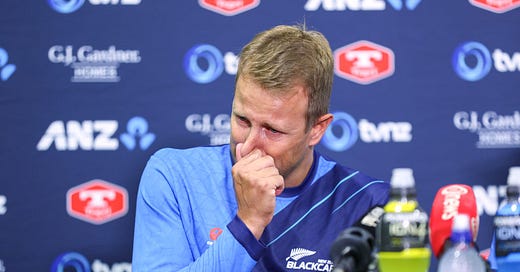



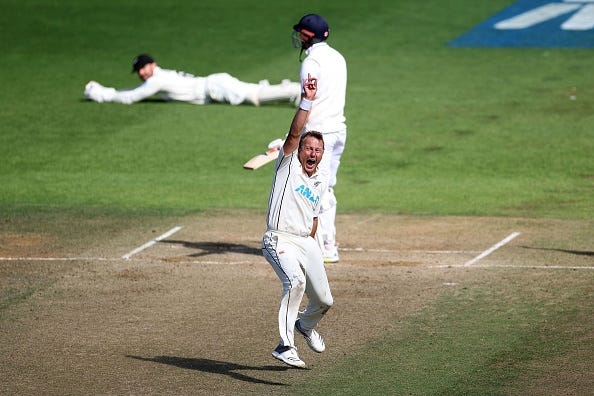
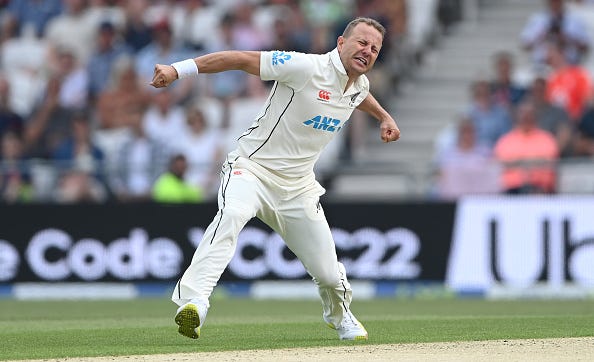
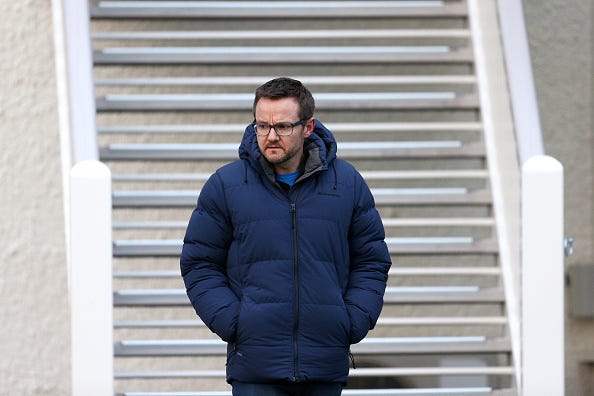
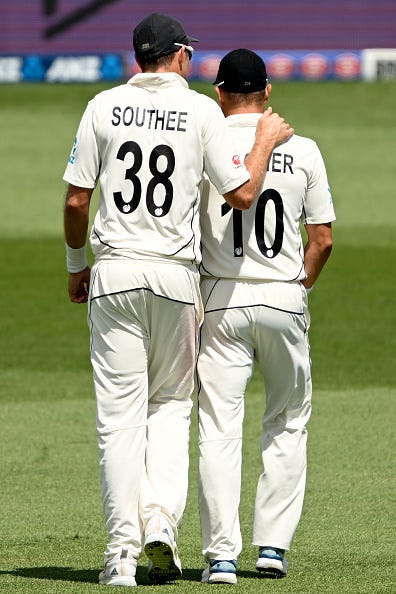
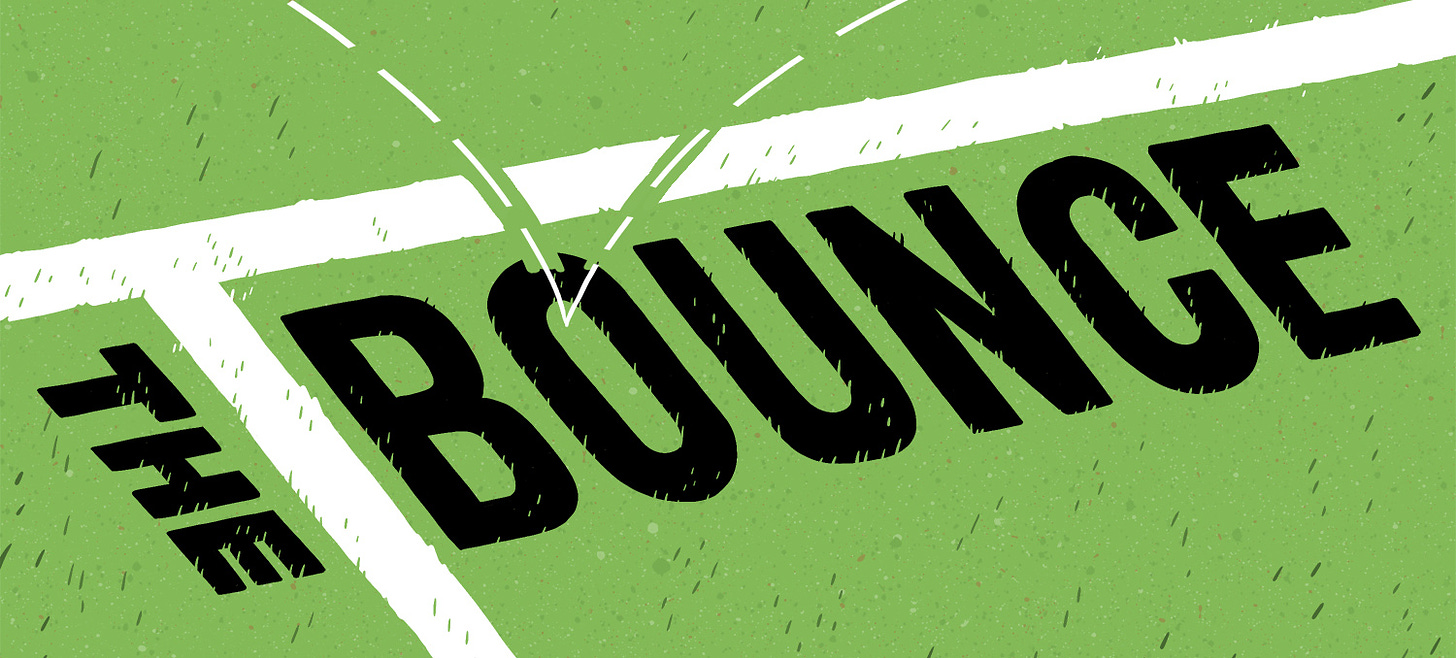
For all Wagners heroics with the ball, it is his innings with Ish Sodhi to save the 2nd Test match and win the series in 2018 that I find to be particularly memorable. Mainly, for the foresight to review his caught behind dismissal and start walking off in the fading light and ensure there would be no time left for any sort of miracle.
Helluva write up Dylan. Thanks for publishing the exert. I've got the book (thanks to my Bounce subscription!) but hadn't read his section yet.
Dead. Set. Legend.